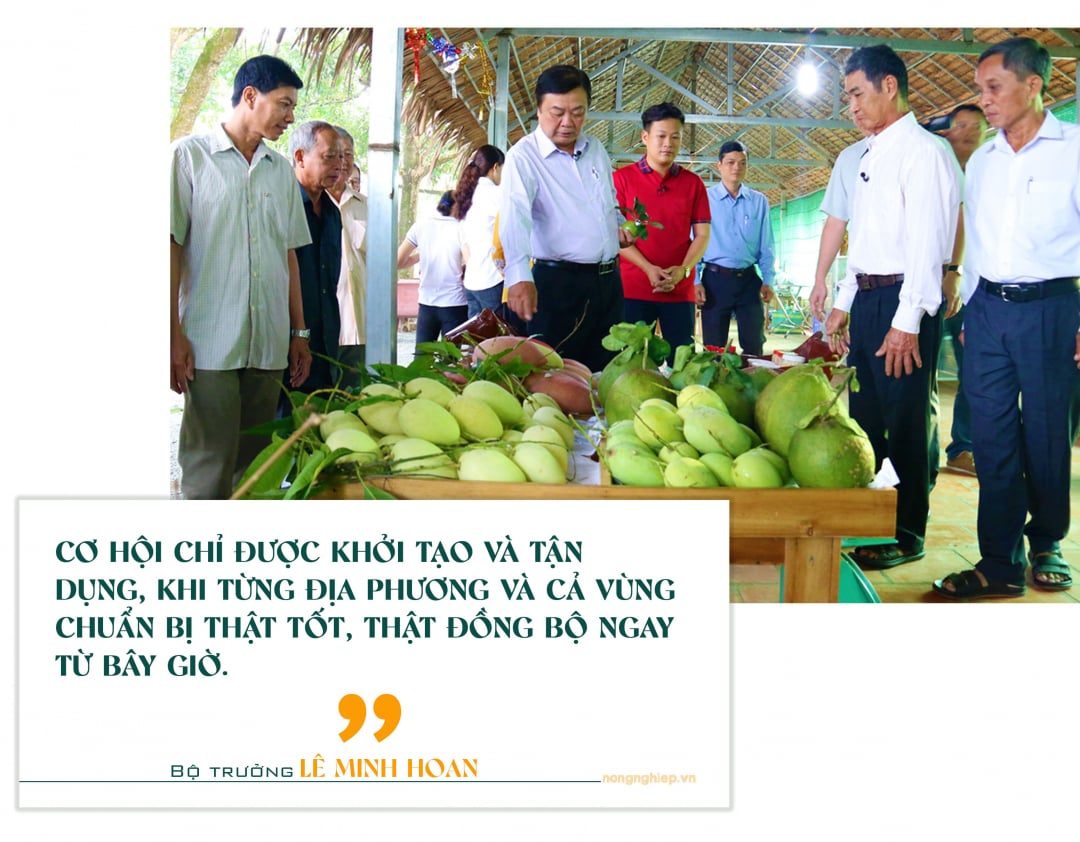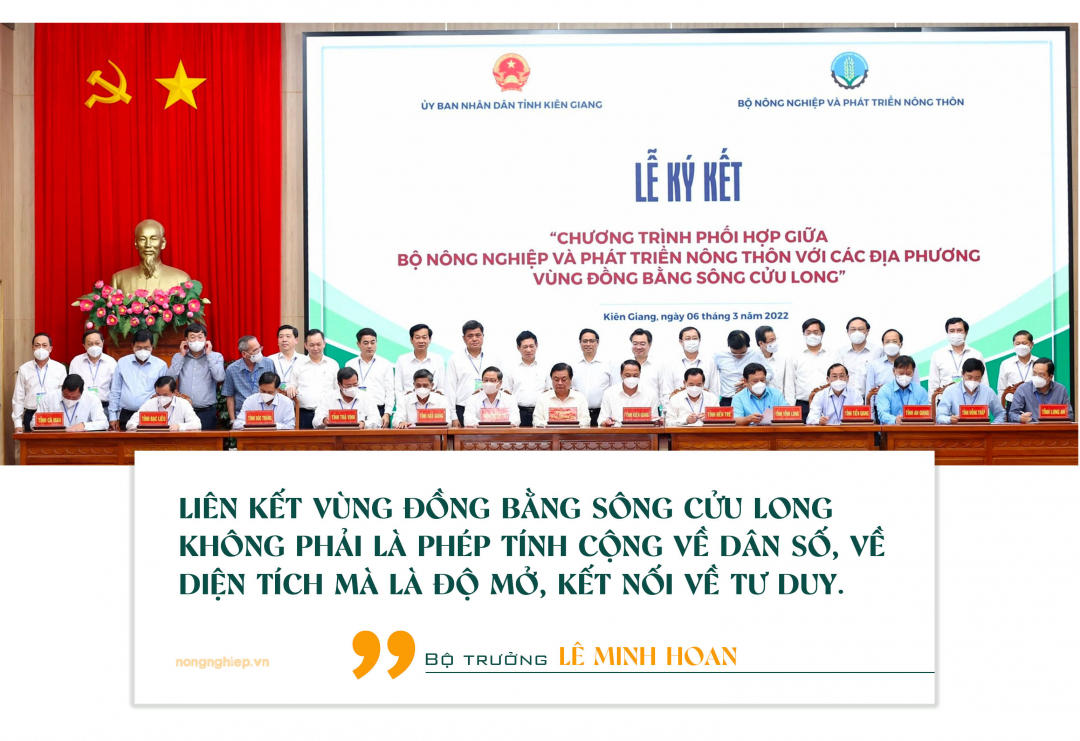June 21, 2025 | 03:51 GMT +7
June 21, 2025 | 03:51 GMT +7
Hotline: 0913.378.918
June 21, 2025 | 03:51 GMT +7
Hotline: 0913.378.918
Minister of Agriculture and Rural Development Le Minh Hoan had just delivered a speech at the Conference "Promoting agriculture development in the Mekong Delta adaptive to climate change" chaired by the Prime Minister on March 6. Vietnam Agriculture News would like to relay his meaningful messages to readers. The title in the article is set by the editorial office.
The Conference "Promoting agriculture development in the Mekong Delta adaptive to climate change" is an important regional event that holds great meaning, right after the Prime Minister’s promulgation of the “2021 - 2030 Strategy for Sustainable Agricultural and Rural Development - vision to 2050”.
Thanks to its geographical location and natural conditions, the Mekong Delta has become a concentrated agroproduction area, approaching the market economy at a very early stage. Agriculture holds a high proportion within the country’s economy compared to the average rate, supplies a variety of commodities such as rice, fruit and seafood, greatly contributing to export turnover. However, for many internal and objective reasons, the Mekong Delta has not taken off as expected.
The Mekong Delta just welcomes another opportunity: The National Assembly has passed a Resolution on piloting a number of specific mechanisms and policies for the development of Can Tho city.
Can Tho - Tay Do has always been identified as a center that connects localities in the region. Along with the road transport system including expressways in the 2021-2025 mid-period, projects on irrigation, natural disaster as well as riverbank and coastal erosion prevention and control, agriculture and rural infrastructure development is under preparation for investment, opening up many new fiscal spaces. The Mekong Delta can gradually clear the bottlenecks as an infrastructure low-lying area as the Prime Minister once mentioned.

For the current Mekong Delta, many opportunities for improvements await.
Opportunities can only be created and put into full use when each locality and region are well-prepared and in sync right at this moment with a ready and active stance. If not, this will forever remain an opportunity.
Let’s all imagine: in the next few years, when the infrastructure systems of transportation, urban, irrigation, disaster prevention, logistics serving agriculture and rural areas are complete, what will become of this Delta?
I am sure that the flow of agro-products to the market will be faster, costs will be lower, and commodity competitiveness will be higher. Enterprises and investors, especially those in the fields of agriculture and rural development, high-tech agriculture, and deep processing will converge in this land.
During these days, along with the inauguration of the Cai Lon - Cai Be irrigation system Project - Phase I, we can feel the excitement of nearly 18 million people in the Delta welcoming the good news from the great decisions of the Party, National Assembly and Government.
Harboring such excitement and optimism, there are still many worries about the Mekong Delta agriculture which is also the concern of the Prime Minister after many conferences and meetings with localities and people in the region. It is time for the Delta to have a newer, bigger, bolder way of thinking to activate this rich land full of potential.

“Opportunities can only be created and put into full use when each locality and region are well-prepared and in sync right at this moment with a ready and active stance” - Minister Le Minh Hoan.
Vietnam's agriculture, including the Mekong Delta, is facing great challenges: climate change, market fluctuations, movements in world consumption trends. The disruption of the global supply chain during the Covid-19 pandemic as well as the hot news and topics these days are clear evidence of a “volatile, uncertain, complex and ambiguous” world.
But in my opinion, there is a bigger challenge, mentioned many times on many forums, that is, "fragmented, small, spontaneous", "lacking in terms of regional linkage" agriculture.
That challenge is like a curse and will be difficult to create rapid development in quality if not overcome. Agro-products may always face fierce competition in the fast-changing and highly-unpredictable market - a gateway to many opportunities thanks to new-generation free trade agreements, also a new wave of barriers due to many countries’ trade protectionism and food autonomy strategies.
The Mekong Delta consists of 13 provinces and cities, approximately 150 district-level units, over 1000 commune-level units, and nearly 10 million farming households standing in front of a choice of switching from "agroproduction thinking" to "agroeconomy economy”.
Natural ecosystems and biodiversity have been degraded after a long time of overusing fertilizers and pesticides, posing great threats to the path towards green agriculture.
Farmers’ seasonal mindset and companies’ business-oriented vision inadvertently interfere with the goal of sustainable linkage between production and consumption.
Raw material areas of rice, fruit, and seafood are fragmented and stay the same, making it difficult to promote agro-product images, build brands and boost trading activities.
The existing problems show that no matter how invested the infrastructure is, if the above bottlenecks are not resolved adequately, it will be difficult to improve the imbalance of supply and demand at a faster pace.
The path towards high-quality market, high added value agro-products, and farmers’ increase in income is becoming further and further. Coordination along the commodity chain, regional and sub-regional linkages between localities require full attention right at the beginning of the crop instead of just focusing on handling the situation when agro-products are stagnant after harvest.
Each locality needs to actively expand the connection and development space. Land can be fragmented, administrative boundaries can be divided, but the mindset cannot be fragmented, economic space cannot be divided.
A foreign businessman once told me: "Many international investors may find it difficult to accurately identify each individual location, but they certainly know the Mekong Delta - ‘the Land of Nine Dragons’ of Vietnam".
Agroproduction more or less impacts climate change. At the recent Conference of the Parties (COP26), the Prime Minister pledged that by 2050 Vietnam will attain a carbon-balanced economy.
If climate change is a challenge, then from a positive perspective, solving this challenge means making a name out of the Mekong Delta itself. The "Mekong Delta" franchise will then be deeply engraved in people’s minds with the image of a delta that, despite being heavily influenced by nature, knows how to proactively adapt, overcome challenges and develop in a smart, harmonious, favorable way.
The Ministry of Agriculture and Rural Development (MARD) will open the Agriculture Coordinating Office for the Mekong Delta Region in Can Tho.
We will aid the coordination of production planning and standardization of raw material areas; connect enterprises investing in high-tech agriculture and deep processing; connect commodity chains, support to improve the quality of cooperatives and form a link between production and consumption; coordinate the operation of irrigation works to ensure the synchronicity of the whole system; promote regional agricultural digital transformation.
We will also provide assistance to inter-provincial and inter-regional international funded projects, harmoniously combining investment of structural and non-structural solutions and expanding rural economic space.
The MARD is actively negotiating and calling for more investment projects in agricultural and rural logistics infrastructure, including agro-product preservation cold storage chains at inter-district, inter-provincial levels along Hau and Tien rivers.
I hope that by 2025, together with the systems of transport infrastructure, agricultural infrastructure, and social infrastructure, aspects such as education, human resources, and regional thinking will truly define the sustainable development for this Mekong Delta.

"The connection of the Mekong Delta is not an addition equation of population and area, but the openness and connection of the mind" - Minister Le Minh Hoan.
Ecological, multi-valued and nature-friendly integrated agricultural models have recently appeared in many localities in the region: economic model under forest canopy, shrimp-rice model in Ca Mau peninsula, conversion model from rice monoculture to multi-cropping and intercropping, and production model adaptive to drought and salinity in coastal provinces.
The "One Commune One Product" program has attracted the interest of many localities, delicately combining indigenous resources with local cultural values. Large corporations and enterprises have also implemented inter-provincial projects, promising to initiate the full potential of many localities at the same time.
Those are optimistic signals that demonstrate the creativity, dynamism and vitality of the Delta. The point is that we need to connect and spread those values even further.
The connection of the Mekong Delta is not an addition equation of population and area, but the openness and connection of the mind of the 13 provinces and cities. It is the connection of invisible and limitless resources, creating a harmonious relationship between "Government - Market - Society", seeking new impulses, shaping new development space.
By then, each locality, with its own specific conditions and strengths, will actively and harmoniously contribute to the overall economic space. The Delta will become a complete economic entity, operating flexibly and dynamically.
By then, people will stand firm as the prime subject. Their quality of life will remarkably improve.
By then, the haunting and tormenting questions such as "Where lies the future of the West?", the constant worries and pains about the wave of migration, abandoning the countryside, the homeland will only remain as stories of a hard time that has long been over.

Translated by Samuel Pham
![Turning wind and rain into action: [9] Digitizing hydrometeorological data in response to climate change](https://t.ex-cdn.com/nongnghiepmoitruong.vn/608w/files/news/2025/06/17/z6704423696987_15fd32ffc26d590d204d520c9dac6786-nongnghiep-165943.jpg)
(VAN) Farmers have begun accessing hydrometeorological applications to adjust their cropping schedules, aiming to ensure productivity and adapt to climate change.
![Turning wind and rain into action: [8] Real-time salinity detection and early warning technology](https://t.ex-cdn.com/nongnghiepmoitruong.vn/608w/files/news/2025/06/17/z6704423696987_15fd32ffc26d590d204d520c9dac6786-nongnghiep-151127.jpg)
(VAN) Thanks to the integration of modern hydrological-hydraulic models, remote sensing technologies, and artificial intelligence, the accuracy of hydrological forecasting has significantly improved.
![Turning wind and rain into action: [7] Early disaster warnings help marine farmers minimize losses](https://t.ex-cdn.com/nongnghiepmoitruong.vn/608w/files/news/2025/06/17/z6704423696987_15fd32ffc26d590d204d520c9dac6786-nongnghiep-142942.jpg)
(VAN) In recent years, thanks to early disaster warnings and forecasting, marine farmers in Khanh Hoa province have been able to reduce risks and losses, thereby improving production efficiency.
![Turning wind and rain into action: [6] ‘Four on-the-spot’ disaster management software](https://t.ex-cdn.com/nongnghiepmoitruong.vn/608w/files/news/2025/06/17/e5a48259d6a262fc3bb3-nongnghiep-183800.jpg)
(VAN) By simply activating the scenario on the disaster management software, the relevant authorities immediately know how many households need to be evacuated, where to evacuate them to, and by what means of transportation…
![Turning wind and rain into action: [5] Hue applies modern technology in disaster forecasting](https://t.ex-cdn.com/nongnghiepmoitruong.vn/608w/files/news/2025/06/17/z6704423696987_15fd32ffc26d590d204d520c9dac6786-nongnghiep-093938.jpg)
(VAN) In Hue city, modern technology has recently been applied in meteorological and hydrological forecasting and warning, helping to reduce the damage caused by natural disasters.

(VAN) A cutting-edge farming technique being implemented on an experimental ranch in Arizona's Sonoran Desert has already saved a billion gallons of water over five years, according to Civil Eats.

(VAN) Poultry and pig production and the environment can be boosted through enhanced water technology, according to new research.